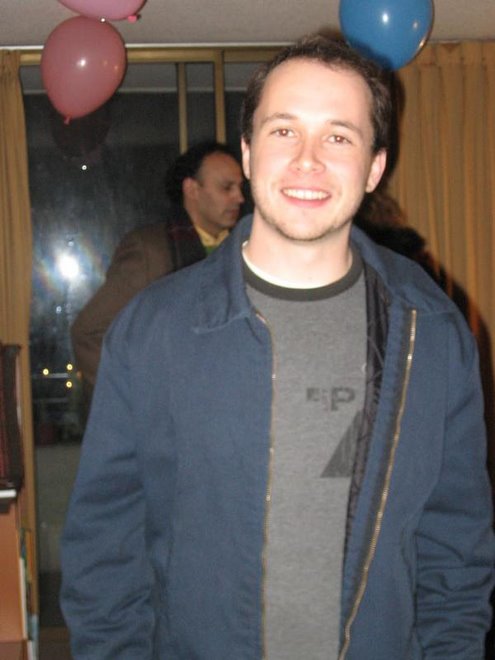 Un gran "órale" a mis cuates en los países hispanoparlantes. Les cuento que estoy impresionado con México, pues todo este tiempo lo tenía al lado y nunca tomé el tiempo para conocerlo. Es una lástima porque es una cultura tan, tan rica, muy latina y a la vez muy cercana a la mía. Aquí estacionar es "parquear," y arrendar es "rentar." Hay más velocidad y más comida rápida, más tallarines ramen y más de lo cosmopolita. Más gente. México realmente está en el mundo, con una cultura globalizada, con hechos que van mucho más allá del discurso globalista (pero más que nada, comercialista) de Chile. Sí hay más pobreza que en Chile, pero menos de lo que hay en la mayoría de los países que he visitado. Y está la esperanza, se siente en el ambiente, de que todo se va mejorando.
Un gran "órale" a mis cuates en los países hispanoparlantes. Les cuento que estoy impresionado con México, pues todo este tiempo lo tenía al lado y nunca tomé el tiempo para conocerlo. Es una lástima porque es una cultura tan, tan rica, muy latina y a la vez muy cercana a la mía. Aquí estacionar es "parquear," y arrendar es "rentar." Hay más velocidad y más comida rápida, más tallarines ramen y más de lo cosmopolita. Más gente. México realmente está en el mundo, con una cultura globalizada, con hechos que van mucho más allá del discurso globalista (pero más que nada, comercialista) de Chile. Sí hay más pobreza que en Chile, pero menos de lo que hay en la mayoría de los países que he visitado. Y está la esperanza, se siente en el ambiente, de que todo se va mejorando.Con la excepción de Oaxaca (hay que agregarlo), donde la atmósfera era más que nada una de conflicto social. Justo el día que nos fuimos de Oaxaca, estallaron desmanes relacionados con las demandas de los profesores de mejores sueldos. O por lo menos, así comenzó la cosa; ahora abarca las demandas históricas de los pobres en una región desigual, latifundista y aún gobernada por el PRI.
Bueno, como puse en mi último posteo en inglés, DF me instó a un estado de delirio. Ya había estado viajando tanto tiempo, pasando por tantas cosas (mi abuelita se murió, me dio una infección de estafilococco, de la que recuperé), tanta logística (que adónde va este bus, que cuándo partimos para Chichén Itzá, que si el taxista me está estafando, que hay que empacar la mochila por enésima vez, que este hotelucho no sirve, que ese camino en bus será de 22 horas aunque cubre una distancia de como 200 km...), tanta cerveza...
 Así es que llegué a DF con las defensas un poco en baja, cuando realmente tienes que estar en forma para enfrentarlo. Es una ciudad maravillosa: el Museo de Antropología tiene unos artefactos impresionantes, el sol azteca para empezar. DF estaba celebrando el centenario del nacimiento de Frida Kahlo con una exhibición en el Palacio de Bellas Artes y otra en la Casa Azul, que es donde vivió ella (y donde vivió León Trotsky hasta que tuvo un affaire con Frida, se enojó su mujer y tuvieron que mandarse a cambiar a una casa cercana, que es donde un asesino catalán lo mató con una piolet a la cabeza, pero esto es otro tema...). Disfruté mucho del Templo Mayor, un gran templo azteca sólo parcialmente excavado al lado de la catedral, en el Zócalo de la ciudad.
Así es que llegué a DF con las defensas un poco en baja, cuando realmente tienes que estar en forma para enfrentarlo. Es una ciudad maravillosa: el Museo de Antropología tiene unos artefactos impresionantes, el sol azteca para empezar. DF estaba celebrando el centenario del nacimiento de Frida Kahlo con una exhibición en el Palacio de Bellas Artes y otra en la Casa Azul, que es donde vivió ella (y donde vivió León Trotsky hasta que tuvo un affaire con Frida, se enojó su mujer y tuvieron que mandarse a cambiar a una casa cercana, que es donde un asesino catalán lo mató con una piolet a la cabeza, pero esto es otro tema...). Disfruté mucho del Templo Mayor, un gran templo azteca sólo parcialmente excavado al lado de la catedral, en el Zócalo de la ciudad.DF, o por lo menos las partes turísticas, tiene una estética única. Tiene elementos de lo futurista kitsch (lo que pensaban que iba a ser el futuro en los años 60, onda Tomorrowlandia), lo azteca guerrillero de las ruinas, lo colonial de la llegada de los españoles y lo decimonónico afrancesado del Porfiriato. Es una mezcla inolvidable, y por más dispares que parezcan los elementos que la componen, es una mezcla que funciona. Esto es el encanto de México, para mí: el hallazgo de la coherencia en una variedad muy rara e improbable de elementos.
 Y claro, no me puedo olvidar de los pirámides de Teotihuacán. A sólo una hora de DF, pero en otro mundo.
Y claro, no me puedo olvidar de los pirámides de Teotihuacán. A sólo una hora de DF, pero en otro mundo.O sea: desorientación y delirio. DF me agotó. Y llegué a la conclusión de que no me quedaba otro remedio que irme para la casa, ahora ya. Y me fui.



























